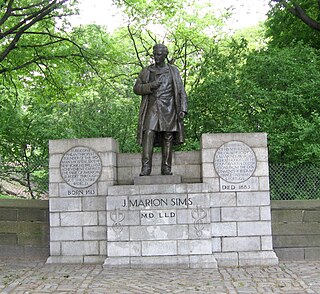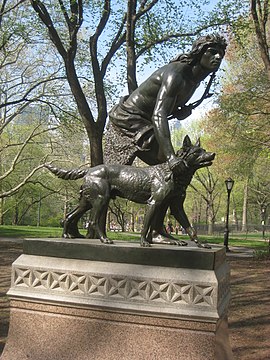
John Quincy Adams Ward was an American sculptor, whose most familiar work is his larger than life-size standing statue of George Washington on the steps of Federal Hall National Memorial in New York City.

New York City's 843-acre (3.41 km2) Central Park is the home of many works of public art in various media, such as bronze, stone, and tile. Many are sculptures in the form of busts, statues, equestrian statues, and panels carved or cast in low relief. Others are two-dimensional bronze or tile plaques. Some artworks do double-duty as fountains, or as part of fountains; some serve as memorials dedicated to a cause, to notable individuals, and in one case, to a notable animal. Most were donated by individuals or civic organizations; only a few were funded by the city.

General Philip Sheridan is a bronze sculpture that honors Civil War general Philip Sheridan. The monument was sculpted by Gutzon Borglum, best known for his design of Mount Rushmore. Dedicated in 1908, dignitaries in attendance at the unveiling ceremony included President Theodore Roosevelt, members of the President's cabinet, high-ranking military officers and veterans from the Civil War and Spanish–American War. The equestrian statue is located in the center of Sheridan Circle in the Sheridan-Kalorama neighborhood of Washington, D.C. The bronze statue, surrounded by a plaza and park, is one of eighteen Civil War monuments in Washington, D.C., which were collectively listed on the National Register of Historic Places in 1978. The sculpture and surrounding park are owned and maintained by the National Park Service, a federal agency of the Interior Department.

The fourth plinth is the northwest plinth in Trafalgar Square in central London. It was originally intended to hold an equestrian statue of William IV, but remained empty due to lack of funds. For over 150 years, its use was debated; in 1998, the Royal Society for the encouragement of Arts, Manufactures and Commerce (RSA) commissioned three contemporary sculptures to be displayed temporarily on the plinth. Shortly afterwards, Chris Smith, Secretary of State for Culture, Media and Sport, commissioned Sir John Mortimer to seek opinions from public art commissioners, critics and members of the public as to its future. Mortimer's final report recommended that there continue to be a rolling programme of commissioned temporary artworks rather than settle permanently on one figure or idea.

Major General George Henry Thomas, also known as the Thomas Circle Monument, is an equestrian sculpture in Washington, D.C. that honors Civil War general George Henry Thomas. The monument is located in the center of Thomas Circle, on the border of the downtown and Logan Circle neighborhoods. It was sculpted by John Quincy Adams Ward, best known for his work on the statue of George Washington in Wall Street, Manhattan. Attendees at the dedication in 1879 included President Rutherford B. Hayes, Generals Irvin McDowell, Philip Sheridan, and William Tecumseh Sherman, senators and thousands of soldiers.

The Henry Ward Beecher Monument, a statue of Henry Ward Beecher created by the sculptor John Quincy Adams Ward, was unveiled on June 24, 1891, in Borough Hall Park, Brooklyn and was later relocated to Cadman Plaza, Brooklyn in 1959.

George Washington is a large bronze sculpture of George Washington by John Quincy Adams Ward, installed on the front steps of Federal Hall National Memorial on Wall Street in New York City.

William Shakespeare is an outdoor bronze sculpture of William Shakespeare by John Quincy Adams Ward, located in Central Park in Manhattan, New York. The statue was created in 1870 and unveiled in Central Park in 1872. Four thousand dollars towards the funding of the statue was raised at a benefit performance of Julius Caesar on November 24, 1864, performed by the sons of Junius Brutus Booth at the Winter Garden Theater.

Seventh Regiment Memorial is an outdoor bronze sculpture atop a granite base honoring those members of the regiment whose lives were lost during the Civil War. The sculptor John Quincy Adams Ward created the statue and the architect Richard Morris Hunt designed the base. Although the statue is dated 1869 the monument was not unveiled until June 22, 1874.

An outdoor bronze bust of Alexander Lyman Holley by artist John Quincy Adams Ward and architect Thomas Hastings is installed in Washington Square Park in Manhattan, New York. Cast by the Henry-Bonnard Bronze Company of New York and dedicated in 1889, the sculpture is set on an Indiana limestone pedestal and displays a Beaux-Arts style design.

William Earl Dodge is an outdoor bronze sculpture of William E. Dodge by John Quincy Adams Ward, located at Bryant Park in Manhattan, New York. It was cast in 1885 and dedicated on October 22 of that year.

An outdoor bronze sculpture of Horace Greeley by artist John Quincy Adams Ward and architect Richard Morris Hunt is located in City Hall Park in Manhattan, New York. Cast in 1890, the seated statue is set on a Quincy granite pedestal.

Boadicea and Her Daughters is a bronze sculptural group in London representing Boudica, queen of the Celtic Iceni tribe, who led an uprising in Roman Britain. It is located to the north side of the western end of Westminster Bridge, near Portcullis House and Westminster Pier, facing Big Ben and the Palace of Westminster across the road. It is considered the magnum opus of its sculptor, the English artist and engineer Thomas Thornycroft. Thornycroft worked on it from 1856 until shortly before his death in 1885, sometimes assisted by his son William Hamo Thornycroft, but it was not erected in its current position until 1902.

A 1926–27 statue of George Washington by Italian American artist Pompeo Coppini was installed in northeast Portland, Oregon, United States. The bronze sculpture was the second of three statues of Washington by the artist, following a similar statue installed in Mexico City in 1912 and preceding another installed on the University of Texas at Austin campus in February 1955. The Portland statue was created to commemorate the 1926 sesquicentennial of the Declaration of Independence and dedicated in 1927. It was part of the City of Portland and Multnomah County Public Art Collection courtesy of the Regional Arts & Culture Council. In June 2020, it was toppled by protestors.

A 1965 memorial bust of John F. Kennedy by Jacques Lipchitz stands in the lobby of International Students House on Great Portland Street in London, England, and is visible from the outside through the glass doors. It was moved there in April 2019 from its original location on the Marylebone Road, to the west of Great Portland Street underground station, after it was vandalised in 2017.

Thomas Jefferson is a 1911 bronze statue of a seated Thomas Jefferson created by Karl Bitter for the Cuyahoga County Courthouse in Cleveland, Ohio, United States.

J. Marion Sims is a bronze sculpture depicting the American physician of the same name by Ferdinand Freiherr von Miller.

General Israel Putnam is a monumental statue in Hartford, Connecticut, United States. Located in the city's Bushnell Park, the statue was designed by sculptor John Quincy Adams Ward and honors Israel Putnam, a military officer in the Continental Army during the American Revolutionary War. The statue was largely paid for by a donation from judge Joseph P. Allyn and was dedicated in a large ceremony in 1874. It was one of the first statues to be erected in the park, which nowadays houses several other monuments to famous Connecticut residents. From an artistic standpoint, the statue has received mixed reviews from critics.



















